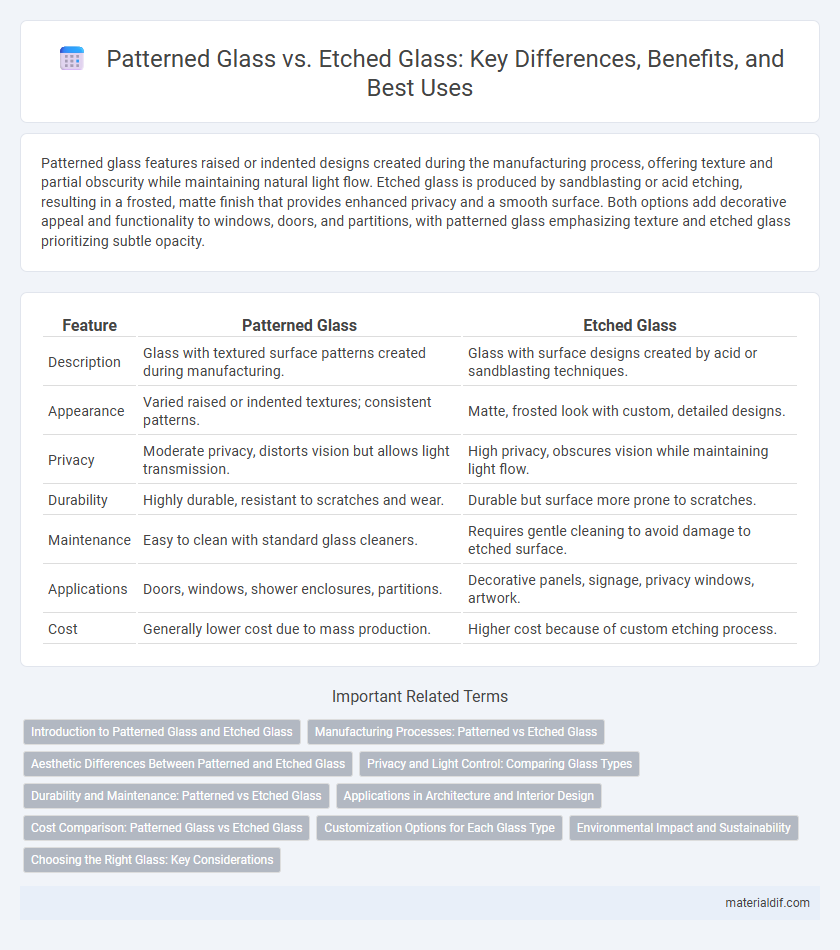Patterned glass features raised or indented designs created during the manufacturing process, offering texture and partial obscurity while maintaining natural light flow. Etched glass is produced by sandblasting or acid etching, resulting in a frosted, matte finish that provides enhanced privacy and a smooth surface. Both options add decorative appeal and functionality to windows, doors, and partitions, with patterned glass emphasizing texture and etched glass prioritizing subtle opacity.
Table of Comparison
| Feature | Patterned Glass | Etched Glass |
|---|---|---|
| Description | Glass with textured surface patterns created during manufacturing. | Glass with surface designs created by acid or sandblasting techniques. |
| Appearance | Varied raised or indented textures; consistent patterns. | Matte, frosted look with custom, detailed designs. |
| Privacy | Moderate privacy, distorts vision but allows light transmission. | High privacy, obscures vision while maintaining light flow. |
| Durability | Highly durable, resistant to scratches and wear. | Durable but surface more prone to scratches. |
| Maintenance | Easy to clean with standard glass cleaners. | Requires gentle cleaning to avoid damage to etched surface. |
| Applications | Doors, windows, shower enclosures, partitions. | Decorative panels, signage, privacy windows, artwork. |
| Cost | Generally lower cost due to mass production. | Higher cost because of custom etching process. |
Introduction to Patterned Glass and Etched Glass
Patterned glass features textured surfaces created during manufacturing by rolling glass over patterned rollers, providing enhanced privacy and decorative effects without compromising natural light. Etched glass is produced by applying acid or sandblasting techniques to create permanent, smooth, matte designs that offer sophisticated aesthetics and subdued transparency. Both types are widely used in architectural and interior design applications for privacy, style, and light diffusion.
Manufacturing Processes: Patterned vs Etched Glass
Patterned glass is produced by pressing molten glass between patterned rollers, creating raised or embossed designs on the surface, which enhances light diffusion and privacy. Etched glass manufacturing involves applying acid or abrasive materials to selectively corrode the glass surface, resulting in a smooth, frosted appearance with intricate custom patterns. These distinct processes influence the texture, translucency, and durability of the glass, impacting its aesthetic and functional applications in architectural and decorative uses.
Aesthetic Differences Between Patterned and Etched Glass
Patterned glass features raised or embossed designs that add texture and depth, creating dynamic light diffusion and visual interest. Etched glass displays smooth, frosted designs created through acid or sandblasting, offering a more subtle and elegant appearance with muted translucency. Both types enhance aesthetic appeal but differ in tactile sensation and how they interact with light.
Privacy and Light Control: Comparing Glass Types
Patterned glass offers varied textures that obscure visibility while allowing natural light to diffuse softly, making it ideal for privacy without sacrificing illumination. Etched glass provides a more permanent, frosted finish that enhances privacy by significantly reducing transparency but still permits some light transmission. Both types balance privacy and light control differently, with patterned glass emphasizing decorative diffusion and etched glass focusing on subtle opacity.
Durability and Maintenance: Patterned vs Etched Glass
Patterned glass typically features raised or recessed designs created during the manufacturing process, resulting in a durable surface resistant to wear and scratches. Etched glass undergoes an acid or abrasive treatment to create frosted, intricate designs that can be more susceptible to damage or staining over time. Maintenance for patterned glass is generally easier, requiring simple cleaning without concern for surface abrasion, whereas etched glass demands gentle cleaning to preserve its delicate texture and appearance.
Applications in Architecture and Interior Design
Patterned glass is widely used in architectural applications for creating decorative facades, partitions, and windows that allow light diffusion while providing privacy. Etched glass finds extensive use in interior design for customized wall panels, doors, and shower enclosures, offering a matte finish that enhances aesthetic appeal and reduces glare. Both types improve spatial ambiance and contribute to energy efficiency by controlling light transmission and privacy levels in residential and commercial buildings.
Cost Comparison: Patterned Glass vs Etched Glass
Patterned glass generally costs less than etched glass due to simpler manufacturing processes like rolling or pressing to create textures. Etched glass involves chemical or sandblasting techniques, which require more labor and precision, driving up production expenses. For budget-conscious projects, patterned glass offers a cost-effective alternative while still providing aesthetic and privacy benefits.
Customization Options for Each Glass Type
Patterned glass offers a variety of pre-designed textures and motifs that provide distinctive light diffusion and privacy, with customization options focused mainly on selecting from established patterns and colors. Etched glass allows for more precise and intricate customization through laser or acid-etching techniques, enabling bespoke designs, logos, or text tailored to specific aesthetic requirements. Both types provide unique personalization possibilities, but etched glass is preferred for detailed, artistic customization, while patterned glass excels in volume and consistency of design options.
Environmental Impact and Sustainability
Patterned glass often involves pressing or rolling techniques that consume less energy compared to the chemical processes used for etched glass, resulting in a lower environmental footprint. Etched glass requires acids or abrasives that can generate hazardous waste, increasing its ecological impact and complicating disposal or recycling. Choosing patterned glass supports sustainability by reducing harmful emissions and promoting safer manufacturing practices.
Choosing the Right Glass: Key Considerations
Choosing between patterned glass and etched glass depends on the desired level of privacy, aesthetic appeal, and durability. Patterned glass offers textured surfaces that obscure visibility while allowing light transmission, making it ideal for bathroom windows and office partitions. Etched glass provides a smooth, frosted appearance with custom designs created by acid or sandblasting, suited for decorative panels and signage where precise artistry and elegance are prioritized.
Patterned glass vs Etched glass Infographic

 materialdif.com
materialdif.com